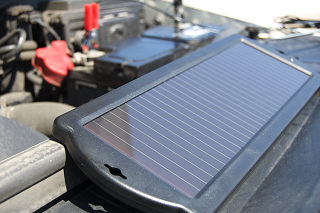From Guest Blogger Kyle Pennell: What Goes in to the Cost of Solar?

The perception by some that solar is too expensive or hard for the average homeowner to adopt is not really true anymore. The combination of better manufacturing processes and government incentives have made solar power a lot more affordable. There are many different factors that go into how much solar infrastructure and generated electricity costs.
One of the biggest reasons solar prices continue to drop are due to government subsidies and incentive programs. Commercial businesses that “invest or purchase solar property” are eligible for a 30% tax credit via the Federal Business Energy Tax Credit. The credit currently runs through 2019. The national government’s SunShot initiative is one of many research and development efforts to drive down the cost of solar electricity and the adoption of solar power.
The Modified Accelerated Cost Recovery System helps businesses recover solar investments through depreciation deductions. Many states also offer incentives for those looking to adopt solar power. Some of the earliest adopters of solar electricity were fueled by incentive programs in states like California, Hawaii and New Jersey. The emphasis by the government to credit consumers for using solar is projected to only expand the solar market.
However, the immense subsidization of power can have some negative effects. When the Nevada Public Utilities Commission decreased the amount of solar subsidies in 2016, many consumers were left stranded. People who were spurned by economic incentives to install solar panels on their homes were left with pricy technology. The infrastructure was now more expensive because consumers could not sell extra electricity back to a power grid. The commission was forced to reverse some of their actions after massive pushback.
Sun differences across the country also play a part in determining solar prices. Photovoltaic solar technology utilizes direct and scattered sunlight to make power. The intensity and duration of sunshine can vary wildly depending on location. Past research has pointed to solar power generally being cheaper in southern states. This is because there is an increased amount of solar radiation hitting panels in places like New Mexico, Arizona, West Texas, Nevada, and Southern California.
The EPA offers up a number of tools and resources for consumers to map out their solar potential and see how much money could be saved. Some programs include Energy Sage, Geostellar, Mapdwell,and OpenEl Solar Mapping Tools.
The actual infrastructure of a solar panel or the larger system plays a role in the cost of solar power. For example, normal industrially produced crystalline solar panels usually have an efficiency from 18-22%. Panels with amorphous silicon technology can have an efficiency level of just 8-13%. More advanced panels using proprietary technology, like ones offered from Sunpower, can reach up to 24% efficiency. Multijunction solar panels can even reach 25-35% efficiency. Panels with greater efficiency will be more expensive. However, they require less area and will be able to create more (and cheaper) power.
A grid-tied solar power system lets consumers hook into a utility company. They are usually handy for slashing electricity bills. However, consumers will lose power unless they have a backup system if the grid goes down. An off-grid system usually has more up-front costs, but the independence of the system can provide peace of mind and eventually provide cost-effective electricity.
Better manufacturing techniques and increased competition have cut the prices of solar installation, system design, and the cost of DC to AC power inverters. This infrastructure innovation has also cut down solar costs even though the price of actual panels has been generally static since 2012, according to Scientific American.
As technology continues to develop, estimates are the price of electricity will continue to drop. For consumers looking to install solar panels on a house, the price of power can be affected by the age and setup of the home. Shade trees on a property can make power more expensive since less solar radiation will hit the panels. An old or dilapidated roof could also hinder the optimal operation of a solar panel. Even worse, using the wrong solar contractor for installation and design could make power more expensive since the panels might not be running at their top level.
Overall, the cost of solar panels and the electricity they produce can vary greatly. Prices have been affected by continued innovation and development of new technology by the private sector and government.
This is a guest post by Kyle Pennell at PowerScout — we help homeowners figure out if installing solar is right for them and get competitive bids from multiple installers. Our long-term mission is to accelerate the adoption of solar (and other smart home improvements), which will help mitigate climate change.
